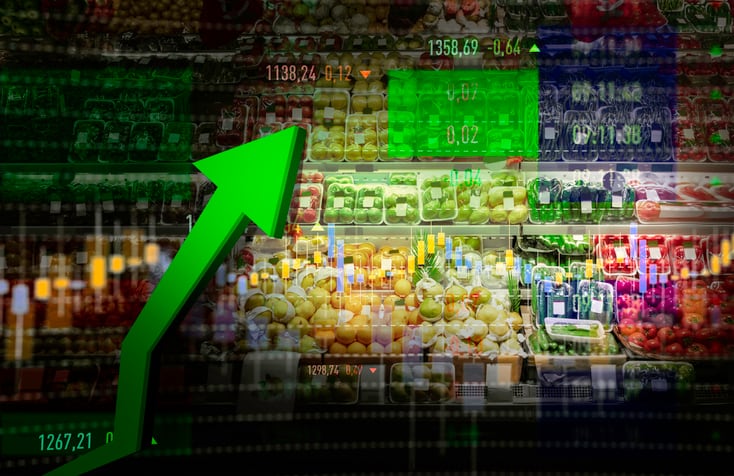“Macroeconomic factors have continued to evolve, creating incremental supply chain uncertainty around the availability of labor and transportation, and multiple extreme weather events have impacted key commodities important to our business.
"As a result, we now anticipate ongoing cost inflation and supply disruption to persist beyond our pervious expectations and through the remainder of the fiscal year,” Smucker said in a prepared statement issued Thursday ahead the company’s first quarter earnings call.
“In response, our teams are implementing additional net pricing actions and cost savings initiatives,” he added.
“However, due to the timing of the cost increases and recovery through higher net pricing, as well as some supply chain distribution, we have revised our expectations and are lowering our full-year adjusted earnings per share outlook by approximately 5%.”
This will reflect steady earnings declines in the second quarter of about 15% followed by more in the third quarter. By the fourth quarter, however, earnings are projected to increase more than 20%, “reflecting higher net pricing catching up to higher costs and the lapping of around $40m of incremental marketing spend in the prior year,” CFO Tucker Marshall said in prepared comments.
Higher than expected inflationary costs
The decision to lower full-year guidance took several analysts off-guard, prompting questions about why well-known inflationary and pandemic-related challenges appear to be hitting Smucker harder than previously anticipated, despite pricing implemented by the company in July and other measures taken to offset higher inputs.
“I’m a little surprised why the near-term headwind is this much worse,” Ken Goldman of JP Morgan told Smucker executives Thursday before asking “what’s hitting you harder than you initially thought?”
Smucker explained that the company previously anticipated mid-single-digit cost inflation as a percentage of total cost of goods sold. Now, however, it is tracking high single-digit cost inflation as a percentage of total cost of goods sold.
“The change from our initial expectation is driven by our commodity and ingredients area, transportation and then packaging,” he explained.
For example, he noted weather negatively impacted coffee production in Brazil, fruit production in the Pacific Northwest and packaging production in Texas, which experienced a brutal winter storm that shut down production and blocked transportation of goods.
Transportation challenges continue “to be real, not only from a labor standpoint, but also a unit standpoint and just an overall sort of backlog in the system that has persisted throughout the entire pandemic,” he said.
For example, he explained, there were some shipments left on the dock at the end of July that should be picked up in August due to labor and transportation issues.
More price increases coming
To offset higher inputs, JM Smucker will push through another round of selective price increases in the second and third quarters, CFO Tucker Marshall said.
While he wouldn’t disclose specific pricing amounts or actions by category or commodity, he noted the company is experiencing double-digit commodity inflation that is resulting in a high single-digit cost of products good sold inflation. This in turn is resulting in a low to mid-single digit pricing at the total company level.
Acknowledging the decision to raise prices again so quickly after an initial round this summer likely will be unpopular with retailers and consumers, Smucker said the company is trying to take a “holistic view” and work closely with retailers to transparently, “prudently and fairly recover essentially the aggregate costs.”
He explained: “When we look at costs and how they impact the finished product, we look at that in totality, and as we go forward with our retail partners, just making sure that we have an open and transparent dialogue of what needs to happen so that we can indeed recover those costs through our entire toolkit, whether that’s the list price, net revenue optimization or what have you.”
Smucker also noted that the challenges the company is facing are “not a symptom-specific to Smucker candidly, this is a symptom-specific to the entire economy.” Thus, other players in the categories where Smucker plays likely will need to make similar decisions and, if they also raise prices, any additional increase taken by the company will not push it out of range.
With this in mind, he said, “we remain confident about the way we’ve executed throughout the entire pandemic and we will be going forward.”
Indeed, the company’s strategic decisions allowed it to still beat market expectations for its sales and profits in the second quarter – even though both fell.
Net sales decreased 6% to $1.86bn versus the prior year, but once divestiture and foreign exchange are taken into account, they increased 1%, building on double-digit growth last year. Gross profit also fell $136m or 18%, reflecting higher costs and inflation related to commodities and transportation.
This prompted the company to lower its earnings per share for the year from a previously expected $8.80-$9.10 to $8.25-$8.65.




